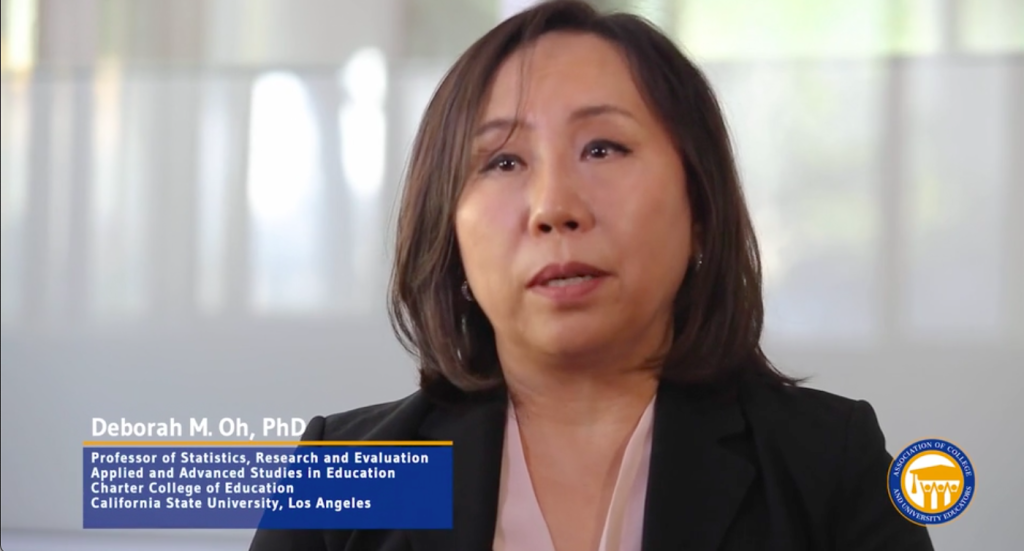
Student-centered Teaching Strategies at Cal State LA
An ACUE-certified course designer at Cal State LA shares two keys to success for scaling student-centered teaching strategies.
In any given academic year, there could be upwards of 1,000 students taking the quantitative reasoning courses in the Charter College of Education at Cal State LA. Deborah Oh has a pretty good idea of how each of them is performing at various points during the semester. She knows who’s passing, missing classes, or falling behind on assignments. Equipped with data and evidence-based practices for student-centered course design, Oh and her colleagues get to work.
It’s halfway through the semester, which is one of three checkpoints when instructors update a master Google spreadsheet managed by Oh. She says this data becomes a powerful signal for how to tailor instruction in the second half of the semester. Each semester, there are dozens of students in “the passing zone.” These are students who are making progress but at risk of not passing. Some need gentle reminders about their missed assignments. For others, personal outreach and targeted intervention from faculty can reignite a student’s motivation.
“We jokingly talk about how we are chasing after them, but we’re showing that we care for them and we want them to succeed in our classes,” said Oh.
Since 2018, when Cal State LA launched a comprehensive plan for redesigning its quantitative reasoning courses, Oh says that pass rates in these gateway courses have increased from 79% to 85%. In one summer session, 94% of students passed the course, officially called Early Start Math (ESM) 1090. For a course that typically enrolls upwards of 1,000 students each year in EDFN 1090/1092, the pass-rate improvement equates to hundreds of more students passing these critical courses.
Looking back on her experience with Cal State LA’s successful course redesign, Oh says that building capacity through a core team of instructional rock stars has been a key to success.
Faculty Lead CSU System Reforms
Faculty across the California State University System (CSU) have played a key role in recent strategic initiatives to increase student retention, completion, and graduation. Most recently, faculty have been crucial levers in response to Executive Order 1110, which required the end of remedial math across CSU by fall 2018.
“The efforts are being led by faculty because they are the ones who best understand that [remediation] is not good for students,” said Alison Wrynn the system’s associate vice chancellor for academic programs, innovations, and faculty development. Under Wrynn and Director Emily Magruder, The CSU Institute for Teaching and Learning (ITL) has seen its mission and scale expand dramatically in recent years. As part of the CSU’s Graduation Initiative 2025, the CSU Institute played a central role in helping campuses redesign entry-level mathematics and writing courses to eliminate pre-requisite remediation.
Cal State LA sprang into action and quickly took a leading role in the remedial education reform. They started with an overhaul of the math curriculum, establishing math pathways that shared common syllabi and assessments. Materials were normed and made more student-centered. students have access to co-requisite “just-in-time support.”
But what Cal State LA believes distinguishes its efforts is an investment in faculty. Oh was one of nearly 60 faculty who received extensive support from their nationally-recognized Center for Effective Teaching and Learning in partnership with ACUE. After Oh earned ACUE’s full certificate in effective college instruction, she co-facilitated the ACUE courses and continues to redesign statistics courses.
“ACUE is all over my course design,” says Oh. “Every assignment has a purpose, and it’s always plugged into the course topic and connected to the course learning outcomes. Guided notes, grading rubrics: Those are all ACUE techniques.”
Cal State LA’s approach has drawn praise for its intentional and strategic approach to incorporating faculty development into student success strategies.
“Cal State LA has been really successful in this work,” said Emily Magruder, who directs the CSU Institute for Teaching and Learning. “They actually incorporated, at scale, parts of the ACUE course, to prepare their math instructors in that preparatory year before implementation.”
In recent years, Oh has focused on building instructional capacity and now works with a team of five ACUE-certified faculty on course redesign.
“Having a team of core instructors who care about the success of their students, who can put our heads together on a consistent basis to look at the data and make informed decisions — that is really, really important.”

